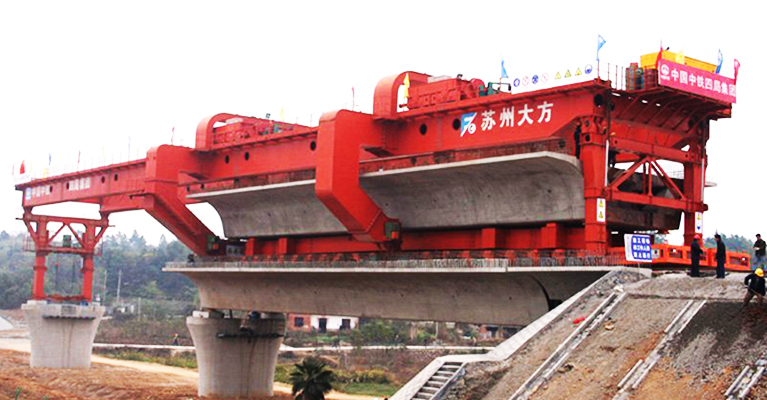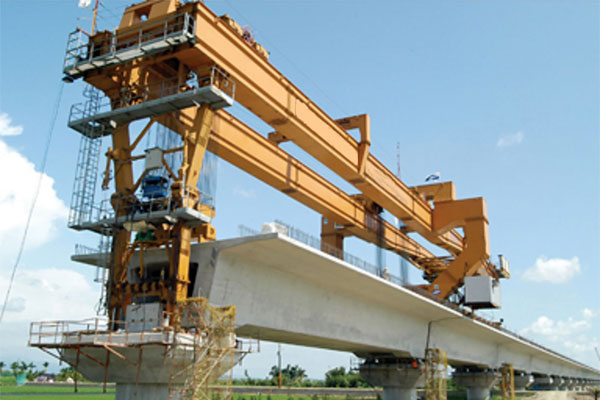Bridge erection is a complex undertaking requiring knowledge and expertise. Several variables, including engineering constraints, costs, and environmental impacts come into play when deciding which construction method. Bridge erection typically involves methods using relatively discrete elements, like piles and girders, which are assembled piece by piece. The selection of the correct equipment, therefore, becomes important. The bridge construction industry is moving toward mechanized construction as this extricates labour, reduces project duration and improves quality. Bridge construction is moving towards the use of mechanised erection equipment. Each type of equipment interacts with the bridge deck differently and this loading has to be accounted for in the design and construction phase analyses. Given below are the different types of bridge deck construction equipment being used across multiple bridge construction projects.
Types of Bridge Deck Erection Equipment
Bridge Beam / Grid launcher
Beam / Grid Launcher is used in the erection of precast beam bridges for span by span method of construction for precast beam girders like U-beam, T-beam, I-beam, etc. This mainly consists of main beam, cantilever beam, under guide beam, front and rear support legs, auxiliary outrigger, hanging beam crane, jib crane and electro-hydraulic system. Designed for precast beam assembly without crane assistance the Beam Launcher is widely used for plain construction, can also meet the requirement for mountain building highway slope, small radius curved bridge, skew bridge and tunnel bridge. There are 2 types of Beam/ Grid Launchers: the single-box type and the double-truss type. Launcher types are used depending on the requirements of the project and with transport trolleys either on rails or with tyres depending on gradient and length of the bridge. The Beam/ Grid Launcher gives a good stability, high efficiency, safety and reliability, easy to adjust variable cross and easy to operate. It has three methods for picking up the precast beam: from rear end of the beam launcher on the deck level, from below on ground level, or from the bridge side. The launcher can accomplish the girder carrying with erecting at the same time. It can also erect 4 pieces of girders with another two cranes one day, saving construction cycles. If the concrete girder is between the two piers, just exchange the front and rear legs, it can continue to work, no extra assembly, shortening the construction period. It comprises a main beam, cantilever, under guide beam, front and rear legs, auxiliary outrigger, hanging beam crane, cantilever crane and electro-hydraulic system.

Gantry cranes
Gantry cranes can be equipped to lift precast beams, or a single crane with double spreaders to lift precast beams. The lifting weight of two cranes that lift at the same time is generally 450 tons, and the lifting weight of a single crane is usually up to 900 tons. The crane is composed of outriggers, crane running and lifting mechanism, which can realize all-round mechanized action. This gantry crane for bridge construction is mainly used to lift and move the precast beam from the beam-making platform to the beam storage platform. After the precast beam is maintained, it will be lifted from the beam storage platform to the beam transport vehicle. The gantry crane can complete the assembly and disassembly of the bridge erector, and it is also used to erect dry bridges with low piers.
The lifting system in gantry cranes adopts a four-point fixed lift beam, which is balanced by the load to ensure the safety of the concrete box girder and the lifting system’s structure. Through the vertical and horizontal fine adjustment of the lifting mechanism, the accuracy of box girder erection can be achieved.

Floating crane
A floating crane is specialised lifting equipment mounted on the vessel, which can be maneuvered to any location in the sea or river for lifting heavy loads. High-capacity floating cranes are mainly used for bridge erection works, installation of offshore platforms and structures, loading and unloading of heavy goods, salvage works, etc. In open sea or sheltered waters, efficiency and flexibility are the main factors of the floating crane.
Modern floating cranes can be mounted on a swing base installed on the deck of a pontoon and can swing in a circular motion both in a clockwise and anticlockwise direction. Apart from pontoon-mounted cranes, some floating cranes barges with a lifting capacity exceeding 10,000 tonnes and are used to transport entire bridge sections. The different types of floating cranes are monohull, catamaran and semi-submersible. Depending on the function, there are two types of floating cranes, the sheer leg crane where the crane is fixed and cannot rotate, and the revolving crane which can revolve all 360 degrees.

Segment lifter
Segment lifter can be best utilized for Balanced cantilever construction where pre-casting is possible and the segment can be transported below the span. This Equipment allows the erection of industrialized segments and faster erection and is therefore addressed to bridges with a great number of spans. Since these are very specialized equipment, the fabrication is mostly done at the centralized fabrication unit and it’s being shipped to various sites.
A segment lifter is launched through a hydraulic system which gives a safe launching for the equipment. The segment lifter allows faster erection and is therefore addressed to bridges with a great number of spans. It is equipped with two electric hoists for lifting the precast segments and adjusting the cross-fall. Segment lifters are usually designed to install segments in ramps, in tight locations, or in areas that are generally difficult to access. It incorporates two primary hydraulic systems providing both lifting of segments and moving of the frame itself during construction when high lifting speeds are required, tandem lifting units or winch systems are utilised on segment lifter.

Underslung Movable Scaffolding System Form
A movable scaffolding system (MSS) is a special-purpose self-launching form used in bridge construction, specifically prestressed concrete bridges with segments or spans that are cast in place. The movable scaffolding system is used to support a form while the concrete is cured; once the segment is complete, the scaffold and forms are moved to the end of the new segment and another segment is poured. While superficially similar, movable scaffolding systems should not be confused with launching gantry machines, which also are used in segmental bridge construction. Both feature long girders spanning multiple bridge spans which move with and temporarily support the work, but launching gantry machines are used to lift and support precast bridge segments and bridge girders, while movable scaffolding systems are used for cast-in-place construction.
The bearing system of the main girder below the bridge deck, external formwork support system on bearing the main girder, the girders system through the leg support on the bearing, and use the high strength fine rolled steel bar to anchor the legs to the piers. The MSS includes a steel structure, working platforms and ladders, internal and external formwork and a set of hydraulic systems that allows to operate the formwork, launch the MSS and transmit the reactions to the columns and deck already cast. The design of the advanced equipment has been improved and optimized over the years, the system is lightweight, easy to assemble, practical in design, supported by internationally known hydraulic and cranage systems, and most importantly, efficient in operation.

Overhead Form Traveller
The overhead form traveller is used for free cantilever construction of post-tensioned box girder – and cable-stayed concrete bridges. The system is lightweight, versatile, easy to assemble and operate, rolling forward on rails, the system can be reset quickly and easily. the system is lightweight, versatile, easy to assemble and operate, rolling forward on rails, the system can be reset quickly and easily.
Form-travelers can be customized both for segment lengths beyond 5m and in other extreme conditions such as very large Width, Multi-Cell Structures. In case, there is a requirement to reduce the weight of the form-traveler for a specific application a customized design can be made for a maximum segment length of 3 to 5m.

Straddle carriers
Straddle carriers are used to load, unload, lift, transport and erect precast top pier segments and bridge segments. It can also be used to lift and transport temporary supports near the pier, and tensioning jacks. The advantage of the straddle carrier is its ability to pick and move extra large girders, segments and materials. The span and lifting height can be designed according to customers’ site requirements.
Latest straddle carriers are equipped with reliable systems of hydraulic equipment, winches, ropes, and electric and hydraulic motors. These highly mechanized machines come complete with emergency features and safety switches to ensure safe use while handling heavy loads.

Conclusion
Modern range of bridge erection equipment are being used for multi-application work requirements.
These applications include erection of precast beams, erection of precast segmental bridges, in-place casting of spans and segments of prestressed-concrete bridges, segmental casting of the concrete slab of composite bridges, transportation and placement of precast spans, hoist macro-segments for suspension bridges etc. Each bridge erection equipment comes with alternate configurations and benefits.
Image source- everestengg.in, adityacranes.com, https://www.bridgeconindia.com, traxnx.com



